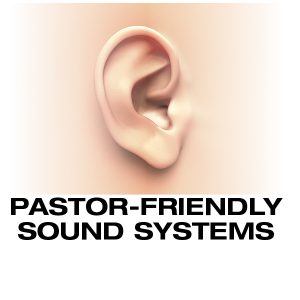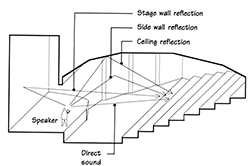
 A sound system is one of the biggest technology investments your church will make. And although you must respect your budget, it would be a serious mistake to cut corners — or just go buy something from a big-box store to save a few bucks.
A sound system is one of the biggest technology investments your church will make. And although you must respect your budget, it would be a serious mistake to cut corners — or just go buy something from a big-box store to save a few bucks.
By Rik Kirby & Daniel Keller
A professional-caliber sound system delivers clear, intelligible sound exactly where your church needs it, with minimal reflections off walls, ceilings and other surfaces. The right system has plenty of power to deliver ample sound without strain, without wasteful overkill or sound levels that overwhelm the room.
Your church’s new sound system should be designed to suit your space and the types of services and other events hosted there. Once you have the right components, they have to be properly and safely installed and then adjusted or “tuned.”
There is much to consider, and it’s important to take time to educate yourself so you can make informed decisions.
 Get professional help
Get professional help
Assessing the acoustics and vagaries of a room and choosing, installing and adjusting professional sound equipment is a job for a skilled system designer and installer. In the long run, the money spent on getting a pro to help plan and install your system is the best expenditure you can make. An experienced systems designer will work with you to create a system that fits your church’s space, message and budget. Your church will get a system that suits its needs for many years to come — and in the long run, it will save money.
When it comes to choosing a designer, there are basically two choices: the “design build” route wherein you choose a company that will design, install and commission the system; or, you can hire a consultant to design the system, with the installation portion going out to bid.
In either scenario, choose your system designer and installer carefully. If you go to an audio equipment dealer, you might only be introduced to products from the lines that dealer sells. Of course, the dealer might happen to carry exactly the right products for your room — or have access to a wide enough selection — but you can’t assume that. You might not always be made aware of all your best alternatives.

This is a good argument for going to an independent systems consultant. These firms and individuals specify products from a very wide group of suppliers. Whether you choose loudspeakers from Company A or from Company Z will be a matter of which best suits your needs.
In the end, the oldest method of finding an installer or consultant is often still the best: word-of-mouth. Begin with contacts at other churches in your region. Talk with people who have been through this process in recent years. Some probably had great experiences with their system designers; perhaps some were not so happy. Learn from both.
Working with your system designer
The designer’s job is to help specify and set up the right system for your church. A good system designer will take the time to communicate with you and get a feel for your overall requirements, budget and special considerations.
For starters, discuss the types of services and events you usually host. The designer’s understanding of how the system will be used is of critical importance. Contemporary services with a praise band, worship music concerts with electronic instruments, and live music for holiday theater productions require a system capable of delivering music with great clarity at relatively high sound levels — without seeming too loud. For this, you need a system that can handle everything from low bass to high frequencies.
Traditional services, on the other hand, might call for a system entirely focused on speech intelligibility. (Your church’s pipe organ and choir probably do not need amplification.) That’s no guarantee, however, that a very simple system is right for your sanctuary. As we’ll discuss next, the acoustics of your space will largely determine the system you need.
Architectural considerations
The architecture and acoustics of your church are a major factor when choosing a sound system. Professional system designers have tools, experience and skills for measuring the acoustical properties of the room and designing a system that will work in your sanctuary. For instance, ensuring that everything is heard clearly in a transept or beyond an archway might present a challenge. Your systems designer should be able to assess these issues, but it won’t hurt for you to point them out.

You also might have special needs related to the room’s architecture about which the designer should be made aware. Perhaps the mixing console must be located in a balcony where it’s currently hard to hear. Armed with this information, the designer might specify loudspeaker arrays that employ steered-beam technology, which enables multiple beams of sound to be directed in very precise ways. One beam might cover that mixing space in the balcony, while other beams of sound fill the main room.
To design these sophisticated systems, most professionals employ acoustic modeling software such as AFMG’s EASE, which provides detailed, realistic modeling and simulation of your sanctuary’s acoustics and potential sound system performance. This takes the guesswork out of system design, helping eliminate costly mistakes and reducing installation time. The designer can predict what works and what doesn’t work before installation begins and changes become more time-consuming and expensive.
We’ll touch on one more architectural consideration: visual impact. Be aware that your new loudspeakers need not detract from your sanctuary’s appearance. Many loudspeaker companies will customize the color of your loudspeakers to match the décor, enabling the speakers to “disappear” into the background. Discuss this with your system designer, who will plan accordingly when specifying speakers.

The cost
Since budget is a major consideration for most churches, discuss your expected costs with the system designer from the start. With a good consultant, you are highly likely to get a knowing and proactive response.
System design professionals can often find ways to save a little money in less important places in order to spend more money where you ought to go a bit higher-end. Perhaps the designer will specify a slightly less expensive speaker for the choir loft but employ a higher-end array for the main part of the sanctuary. Or, maybe by using a larger array, with more beams, the designer can dispense with extra speakers entirely. Your system designer can probably find a variety of ways to meet the room’s challenges while staying within your church’s financial means.
Testing, testing …
Having assessed your church’s needs, the systems designer might bring a sample system into your church so you can hear what it sounds like in your space. Of course, the test system might not be placed exactly like the final installed system. For instance, the test system will probably be mounted on tripods, whereas the installed system might be flown. But, particularly with loudspeakers that can be aimed precisely — such as steered-beam arrays — the test system can give a close approximation of what the final system will sound like.
the installed system might be flown. But, particularly with loudspeakers that can be aimed precisely — such as steered-beam arrays — the test system can give a close approximation of what the final system will sound like.
Let’s get started
As you have seen, choosing a sound system is a complex and multi-faceted process. Today’s loudspeaker systems are more advanced than ever, designed to deliver exceptional fidelity, power and performance.
But, designing the right system doesn’t need to be overwhelming. With the help of a qualified professional, you can create the best possible system for your service, your worship space, and for your budget.
Rik Kirby is Vice President, Sales & Marketing at Renkus-Heinz, Inc. Located in Southern California for more than 35 years, Renkus-Heinz is a manufacturer of high-end professional loudspeaker systems.
Daniel Keller is CEO of Get It In Writing, Inc.®


